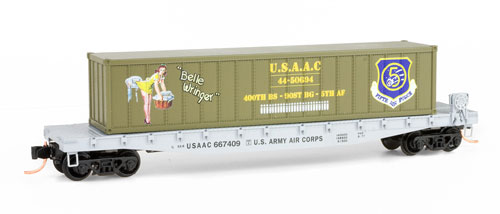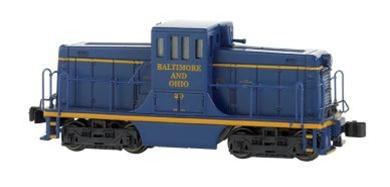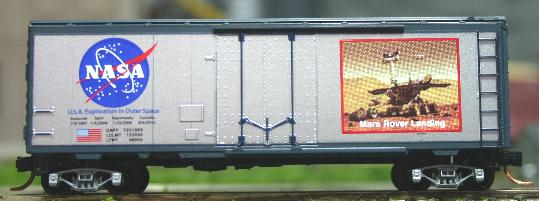Model Information: This model is Micro-Trains most popular flatcar. It models a 50 foot prototype. More than 140 different versions have appeared in Micro-Trains regular releases and many more in special runs.
Prototype History: A flatcar (US) (also flat car (US) or flat wagon (UIC)) is a piece of railroad (US) or railway (non-US) rolling stock that consists of an open, flat deck mounted on a pair of trucks (US) or bogies (UK), one at each end containing four or six wheels. Occasionally, flat cars designed to carry extra heavy or extra large loads are mounted on a pair (or rarely, more) of bogeys under each end . The deck of the car can be wood or steel, and the sides of the deck can include pockets for stakes or tie-down points to secure loads. Flatcars designed for carrying machinery have sliding chain assemblies recessed in the deck.
Flatcars are used for loads that are too large or cumbersome to load in enclosed cars such as boxcars. They are also often used to transport intermodal containers (shipping containers) or trailers as part of intermodal freight transport shipping.
From Wikipedia
Flatcars are used for loads that are too large or cumbersome to load in enclosed cars such as boxcars. They are also often used to transport intermodal containers (shipping containers) or trailers as part of intermodal freight transport shipping.
From Wikipedia
Road Name History: The United States Army Air Corps (USAAC) was the military aviation arm of the United States of America between 1926 and 1941. The statutory administrative forerunner of the United States Air Force, it was renamed from the earlier United States Army Air Service on 2 July 1926 and part of the larger United States Army. The Air Corps was the immediate predecessor of the United States Army Air Forces (USAAF), established on 20 June 1941. Although discontinued as an administrative echelon during World War II, the Air Corps (AC) remained as one of the combat arms of the Army until 1947, when it was legally abolished by legislation establishing the Department of the Air Force.
The Air Corps was renamed by the United States Congress largely as a compromise between the advocates of a separate air arm and those of the traditionalist Army high command who viewed the aviation arm as an auxiliary branch to support the ground forces. Although its members worked to promote the concept of air power and an autonomous air force between the years between the world wars, its primary purpose by Army policy remained support of ground forces rather than independent operations.
On 1 March 1935, still struggling with the issue of a separate air arm, the Army activated the General Headquarters Air Force for centralized control of aviation combat units within the continental United States, separate from but coordinate with the Air Corps. The separation of the Air Corps from control of its combat units caused problems of unity of command that became more acute as the Air Corps enlarged in preparation for World War II. This was resolved by the creation of the Army Air Forces (AAF), making both organizations subordinate to the new higher echelon.
The Air Corps ceased to have an administrative structure after 9 March 1942, but as "the permanent statutory organization of the air arm, and the principal component of the Army Air Forces," the overwhelming majority of personnel assigned to the AAF were members of the Air Corps.
The Air Corps was renamed by the United States Congress largely as a compromise between the advocates of a separate air arm and those of the traditionalist Army high command who viewed the aviation arm as an auxiliary branch to support the ground forces. Although its members worked to promote the concept of air power and an autonomous air force between the years between the world wars, its primary purpose by Army policy remained support of ground forces rather than independent operations.
On 1 March 1935, still struggling with the issue of a separate air arm, the Army activated the General Headquarters Air Force for centralized control of aviation combat units within the continental United States, separate from but coordinate with the Air Corps. The separation of the Air Corps from control of its combat units caused problems of unity of command that became more acute as the Air Corps enlarged in preparation for World War II. This was resolved by the creation of the Army Air Forces (AAF), making both organizations subordinate to the new higher echelon.
The Air Corps ceased to have an administrative structure after 9 March 1942, but as "the permanent statutory organization of the air arm, and the principal component of the Army Air Forces," the overwhelming majority of personnel assigned to the AAF were members of the Air Corps.
Brand/Importer Information: Micro-Trains is the brand name used by both Kadee Quality Products and Micro-Trains Line. For a history of the relationship between the brand and the two companies, please consult our Micro-Trains Collector's Guide.
Manufacturer Information:  Micro-Trains Line split off from Kadee Quality Products in 1990. Kadee Quality Products originally got involved in N-Scale by producing a scaled-down version of their successful HO Magne-Matic knuckle coupler system. This coupler was superior to the ubiquitous 'Rapido' style coupler due to two primary factors: superior realistic appearance and the ability to automatically uncouple when stopped over a magnet embedded in a section of track. The success of these couplers in N-Scale quickly translated to the production of trucks, wheels and in 1972 a release of ready-to-run box cars.
Micro-Trains Line split off from Kadee Quality Products in 1990. Kadee Quality Products originally got involved in N-Scale by producing a scaled-down version of their successful HO Magne-Matic knuckle coupler system. This coupler was superior to the ubiquitous 'Rapido' style coupler due to two primary factors: superior realistic appearance and the ability to automatically uncouple when stopped over a magnet embedded in a section of track. The success of these couplers in N-Scale quickly translated to the production of trucks, wheels and in 1972 a release of ready-to-run box cars.
Micro-Trains Line Co. split off from Kadee in 1990 to form a completely independent company. For this reason, products from this company can appear with labels from both enterprises. Due to the nature of production idiosyncrasies and various random factors, the rolling stock from Micro-Trains can have all sorts of interesting variations in both their packaging as well as the products themselves. When acquiring an MTL product it is very important to understand these important production variations that can greatly enhance (or decrease) the value of your purchase.
Please consult our Micro-Trains Collector's Guide

Micro-Trains Line Co. split off from Kadee in 1990 to form a completely independent company. For this reason, products from this company can appear with labels from both enterprises. Due to the nature of production idiosyncrasies and various random factors, the rolling stock from Micro-Trains can have all sorts of interesting variations in both their packaging as well as the products themselves. When acquiring an MTL product it is very important to understand these important production variations that can greatly enhance (or decrease) the value of your purchase.
Please consult our Micro-Trains Collector's Guide
Item created by: Lethe on 2015-05-31 17:46:30. Last edited by gdm on 2020-06-05 15:25:07
If you see errors or missing data in this entry, please feel free to log in and edit it. Anyone with a Gmail account can log in instantly.
If you see errors or missing data in this entry, please feel free to log in and edit it. Anyone with a Gmail account can log in instantly.










